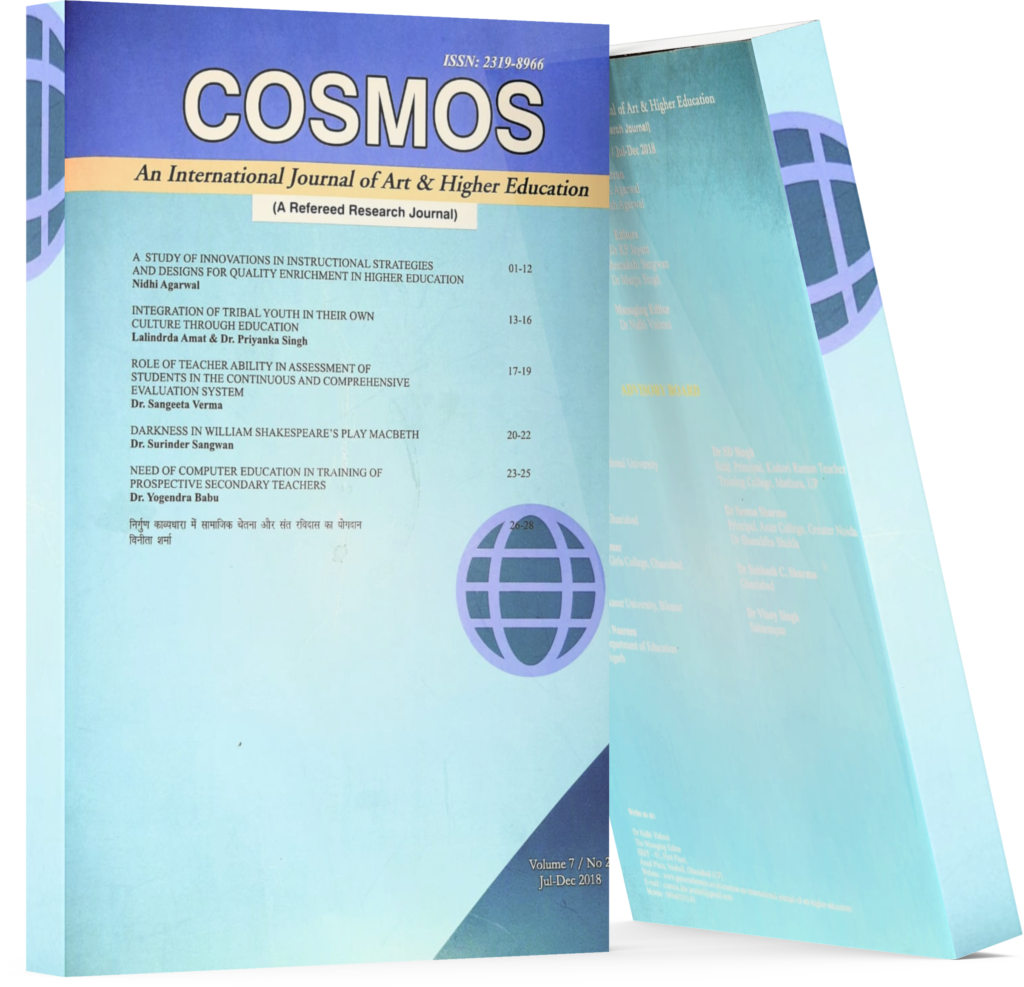Blended Learning - Understanding Its Frameworks And Models
Keywords:
Blended Learning, Teaching-learning Process, CABL (Complex Adaptive Blended Learning System), COI (Community of Inquiry).Abstract
Blended learning is a pioneering idea that has the potential to provide quality education in our Indian society. Our Indian education system cannot completely depend on the face-to-face mode and needs to restructure itself according to the needs and demands of the current situation. In our education system, Blended learning is in the evolving stage; therefore, this paper will help us to understand the different frameworks of blended learning and teaching along with various models or approaches through which the teaching and learning process can be done in the blended classrooms. This will enable practitioners to think and rethink which model or the combinations of models will be effective in the classrooms. Complex Adaptive Blended Learning System (CABLS) and Community of Inquiry (COI) framework will guide us to introspect different aspects and elements of blended learning. These frameworks will provide a complete view of what constitutes blended learning and how different components of blended learning work together over time to achieve an integrated whole.
Downloads
References
Al-Qahtani, A.A. and Higgins, S., (2012). “Effects of traditional, blended, and e-learning
on students’ achievement in higher education”. Journal of Computer Assisted Learning, 29(3), 220-234. Retrieved from
https://doi.org/10.1111/j.1365-
2012.00490.x.
Ayob, N.F.S., Halim, N.D.A., Zulkifli, N.N., Zaid, N.M. & Mokhtar, M., (2020). “Overview of blended learning: The effect of station rotation model on students’ achievement”. Journal of Critical Reviews. Innovare Academics Sciences Pvt. Ltd. https://doi.org/10.31838/jcr.07.06.56
Ayyildiz, Y. and Tarhan, L., (2015). “Development of the self-directed learning skills scale”. International Journal of Lifelong Education, 34(6), 663-679. https://doi.org/
1080/02601370.2015.1091393.
Babadoğan, B. & K, Selvi., “Application and Evaluation of “Self-Directed Learning Skills Scales” to Primary School Students”. Kıymet Selvi. Retrieved from https://www.kiym
etselvi.com/en/2021/07/25/application-and evaluation-of-self-directed-learning-skills scales-to-primary-school-students/.
Beatly, B., (2016). “Hybrid flexible course and program design: Models for student-directed hybrids”. [Blog post] Retrieved from http://www.drbrianbeatty.com/wordpress/
Cleveland-Innes. M. and Wilton. D., (2018). “Guide to Blended Learning”. Common Wealth of Learning: Canada. Retrieved from http://oasis.col.org/handle/11599/3095.
Elizabeth, A., (2019). “(Blended) Learning: How Traditional Best Teaching Practices Impact Blended Elementary Classrooms”, ERIC. Retrieved from
https://eric.ed.gov/?id=EJ1208838
Garrison, D.R. and Arbaugh, J.B., (2007). “Researching the community of inquiry framework: Review, issues, and future directions”. The Internet and Higher Education, 10(3), 157-172.
Garrison, D.R., Anderson, T. and Archer, W., (2000). “Critical inquiry in a text-based environment: Computer conferencing in higher education”. The Internet and Higher Education, 2(2), 87-105.
Geng, S., (2019). “Investigating self-directed learning and technology readiness in blending learning environment”. International Journal of Educational Technology in Higher Education”, Retrieved from
https://educationaltechnologyjournal.springero pen.com/articles/10.1186/s41239-019-0147-0. 11. Graham, C.R., (2004). “Blended Learning Systems: Definition, Current Trends, and Future Directions”. Retrieved from http://Curtbonk.Com/Graham_intro.Pdf. 12. Gündüz, G.F. and VeSelvi, K., (2016). “Developing A “Self-Directed Learning
Preparation Skills Scale for Primary School Students”: Validity and Reliability Analyses”. Universal Journal of Educational Research, 4 (10), 2317-2334. Retrieved from
https://eric.ed.gov/?id=EJ1116384.
James, Cormick Pilling, (1996). “Development of the Self-Directed Learning Perception Scale”. (Thesis), University of Toronto. https://tspace.library.utoronto.ca/bitstream/180
/13188/1/NQ41543.pdf
Kundu, A., Bej, T. and Dey, K.N., (2021). “Time to Achieve: Implementing Blended Learning Routines in an Indian Elementary Classroom”.
https://doi.org/10.1177/0047239520984406. 15. Kundu, A., Bej, T. & Rice, M., (n.d.). “Time to engage: Implementing math and literacy blended learning routines in an Indian elementary classroom”.
https://doi.org/10.1007/s10639-020-10306-0. 16. LaMartina, D., (2012). “Blended MOOCs: The best of both worlds?”. Retrieved from https:// campustechnology.com/articles/2013/08/21/ble nded-moocs-the-best-of-both-worlds. aspx? =CT21.
M.B. Horn and H. Staker, (2011). “The rise of K-12 blended learning”. Innosight Inst., Vol. 5. 18. National Achievement Survey, (2017). NCERT. Retrieved from
https://ncert.nic.in/pdf/NAS/src/Delhi.pdf. Retrieved on 22/07/2021.
National curriculum framework 2005: Position paper on teaching of science, (2006). New Delhi: National Council of Educational Research and Training.
National curriculum framework 2005: Position paper on teaching of social science, (2006). New Delhi: National Council of Educational Research and Training.
National curriculum framework, 2005, (2006). New Delhi: National Council of Educational Research and Training.
National Education Policy, (2020), NCERT, Govt. of India.
Pape, L., (2010). “Blended Teaching and Learning”, www.eddigest.com.
Picciano, A.G., Dziuban, C.D. & Graham, C.R., (2013). “Blended Learning: Research Perspectives”. Volume 2 (1st ed.). Routledge.
Singh, H. and C. Reed, (2001). “A White Paper: Achieving Success with Blended Learning: 2001 ASTD State of the Industry Report”. Alexandria, VA: American Society for Training & Development.
Staker, H., Horn, M.B. & Innosight Institute, (2012). “Classifying K-12 Blended Learning”. ERIC Clearinghouse.
Statistics Solutions, (2021). “Self-Directed Learning Readiness Scale (SDLRS)”. Retrieved
fromhttps://www.statisticssolutions.com/free resources/directory-of-survey-instruments/self directed-learning-readiness-scale-sdlrs/ Retrieved on 20/06/2021.
Tayebinik, M. & Puteh, M., (n.d.). “Blended Learning or E-learning?”
Uz, R. & Uzun, A., (n.d.). “The Influence of Blended Learning Environment on Self Regulated and Self-Directed Learning Skills of Learners”. European Journal of Educational Research, 7(4), 877-886.
https://doi.org/10.12973/eu-jer.7.4.877
Wang, Y., Han, X. and Yang, J., (2015). “International Forum of Educational Technology & Society Revisiting the Blended Learning Literature: Using a Complex Adaptive Systems Framework. Source”. Journal of Educational Technology & Society, 18(2), 380-393.

